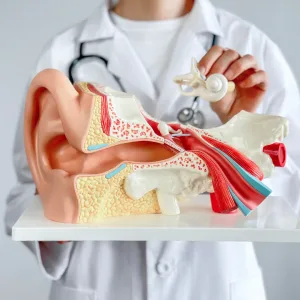Can Hearing Damage Be Reversed? Exploring the Possibilities
Have you ever wondered, “Can hearing damage be reversed?” You’re not alone. Many people ask this question when they notice changes in their hearing. Let’s explore this intriguing question. The answer involves understanding different hearing loss types and the treatments available.
A Closer Look at Hearing Loss
Hearing loss doesn’t come in one shape or size. It varies greatly among individuals. This variation stems from the type of hearing loss and its cause. Understanding these types is the first step in addressing hearing concerns.
The Science of Hearing: Unpacking How We Hear
Our ears are fascinating organs that let us connect with the world through sound. To grasp hearing loss, we first need to understand how hearing works.
Breaking Down the Ear’s Anatomy
The ear has three main parts:
- Outer Ear: This is on the side of your head. It channels sound waves into the ear.
- Middle Ear: Home to the eardrum and three tiny bones, this area amplifies vibrations.
- Inner Ear: This contains the cochlea, a fluid-filled chamber that senses sound waves.

How We Hear: A Step-by-Step Journey
- Sound Waves Enter: They’re funneled by the outer ear into the ear canal.
- Eardrum Vibrates: This is your eardrum’s reaction to sound waves.
- Bones Transmit Vibrations: The tiny bones in the middle ear carry on the process.
- Cochlea Gets Involved: The inner ear’s cochlea takes over, moving its fluid.
- Hair Cells Move: This movement activates hair cells in the cochlea.
- Conversion to Electrical Signals: Hair cells turn these vibrations into signals.
- Travel Via Auditory Nerve: These signals move to the brain through this nerve.
- Brain Interprets Sounds: Finally, your brain makes sense of all this as sound.
Hearing loss can occur when any part of this complex system is damaged. This overview sets the stage for exploring how to reverse hearing damage. Stay tuned as we delve deeper into solutions and innovations in hearing health.
What is Hearing Damage?
Hearing loss comes in different forms. Identifying the type is essential for finding the right approach to manage or reverse hearing damage.
- Sensorineural Hearing Loss: The front-runner in hearing loss types. It’s usually permanent, stemming from inner ear or nerve damage. Loud noises, aging, genetics, or certain medications often trigger it. Think of it as a glitch in the system where sound signals don’t reach the brain as they should.
- Conductive Hearing Loss: This is less common but important to understand. Something blocks sound from getting through the outer or middle ear. Causes might include earwax build-up, infections, or a perforated eardrum. The good news? Sometimes, it’s a temporary setback.
- Mixed Hearing Loss: As the name suggests, this combines the challenges of sensorineural and conductive hearing loss. It’s like facing a double-whammy where both transmission and perception of sound are affected.
Each type of hearing loss brings challenges and opportunities for damage reversal.
Can Hearing Damage Be Reversed? Current Treatments for Hearing Loss
Hearing damage reversal depends on the type and situation, but you can definitely treat it.
For Those Facing Conductive Hearing Loss
When issues in the outer or middle ear block sound waves, you’re dealing with conductive hearing loss. Here’s how you can manage it:
- Earwax Removal: A hearing care provider can safely clear earwax buildup, often restoring hearing quickly.
- Medications: Antibiotics might clear up the issue if infections are at play.
- Surgery: Structural problems or damage? Surgery could be the answer.
- Bone Conduction Aids: These devices bypass problematic areas, sending sound straight to the inner ear.
Sensorineural Hearing Loss Solutions
This common hearing loss type involves inner ear or auditory nerve damage. Here’s what might help:
- Hearing Aids: They amplify sound, aiding those with sensorineural hearing loss to hear better.
- Cochlear Implants: For severe cases, these implants can significantly improve hearing when hearing aids aren’t enough.
Tackling Mixed Hearing Loss
Mixed hearing loss means you’re facing both conductive and sensorineural challenges. Treatment may combine strategies from both types and be tailored to your specific needs.
Beyond Specific Types: Additional Support
Regardless of hearing loss type, some tools and strategies can enhance hearing:
- Assistive Listening Devices: These devices make specific listening situations easier, from amplified phones to FM systems.
- Addressing the Root Cause: Sometimes, tackling the underlying issue—like Meniere’s disease or medication effects—can improve hearing or halt further loss.
Understanding the available treatments empowers you to take the following steps toward better hearing. Many people find ways to improve their hearing experience through technology, medical intervention, or lifestyle adjustments.
Understand more about ototoxic medications.

Can Hearing Damage Be Reversed? Emerging Research and Breakthroughs
The question, “Can hearing damage be reversed?” sparks hope with recent scientific breakthroughs. Let’s dive into groundbreaking research promising new paths for those with genetic hearing loss.
A Leap Forward in Genetic Hearing Loss Research
Scientists are making strides in understanding and potentially reversing genetic hearing loss. A pioneering study has shown that activating a specific gene might reverse hearing loss in mice, which could lead to future treatments in humans.
Groundbreaking Study Unveils Potential Treatment
Karen Steel, a leading geneticist from King’s College London, spearheaded a study that brings new insights. The team focused on a gene linked to early onset deafness in mice, with eye-opening results.
The Science Behind the Breakthrough
The gene in question, spinster homolog 2 (Spns2), plays a critical role in hearing. Mutations in Spns2 lead to a drop in the inner ear’s electrical force, essential for hearing. The researchers engineered a way to reverse this mutation using a simple treatment.
Window of Opportunity Identified
The study found a critical period after birth when intervention could reverse hearing loss. Treating mice with a specific compound significantly restored their hearing capabilities.
Promising Results from Gene Reactivation
Post-treatment, mice showed improved hearing and healthier inner ear cell structures, suggesting that the treatment profoundly impacted overall auditory health.
Early Intervention Shows Better Outcomes
The timing of the gene activation proved vital. Earlier treatment led to more significant improvements, highlighting the importance of timely intervention.
What This Means for Future Treatments
This research offers a glimpse into potential therapies for genetic hearing loss. While still in the early days, reversing hearing damage in humans appears more achievable than ever.
As science advances, the dream of restoring hearing for those with genetic conditions gets closer to reality. This journey of discovery continues to inspire hope for a future where hearing loss could be reversed, changing lives forever.
The Future of Hearing Loss Treatment: Will We Be Able To Reverse Hearing Damage Someday?
As we ponder whether “Can hearing damage be reversed,” let’s bite into the core of promising research, like choosing a healthy apple for a snack. Imagine the sound of that crunch, and now, think of safeguarding your ears at a loud concert with the same care.
Protecting our hearing is crucial, especially since our cochlear hair cells, the heroes of sound detection, cannot bounce back once damaged. Loud noises pose a risk, from rock concerts to construction sites. Yet, there’s a glimmer of hope on the horizon, inspired by nature’s own regenerators: birds and fish.
Researchers at the Del Monte Institute for Neuroscience are making strides in unlocking the secrets of hair cell regeneration in mammals. Their work illuminates possible future therapies for regenerating these crucial cells.
Revolutionary Findings in Regeneration Research
Patricia White, Ph.D., and her University of Rochester Medical Center team have been at the forefront of this research. They’ve delved into how activating a specific growth gene, ERBB2, sparks new life into cochlear hair cells in mammals.
Their groundbreaking study revealed a chain reaction of cellular events that led to the multiplication of cochlear support cells. These cells awaken neighboring stem cells, transforming them into new sensory hair cells. This study offers a glimpse into a future where hearing loss could be a reversible condition.
Unlocking the Mechanism of Regeneration
Through meticulous research, including single-cell RNA sequencing, the team uncovered how ERBB2 signaling encourages stem cell-like behaviors. This process initiates the production of proteins essential for regeneration, such as SPP1, which communicates through the CD44 receptor in supporting cochlear cells.
This research isn’t just theoretical; it has practical implications. The team demonstrated that activating ERBB2 in adult mice could foster new hair cell growth. This discovery is a game-changer, suggesting that regeneration isn’t limited to early development stages but could also be induced in adults.
Looking Ahead: From Discovery to Real-World Application
The team’s ambition doesn’t stop at understanding this process. They’re driven by the goal of applying these insights to improve auditory function in mammals post-damage. This journey towards reversing hearing damage in adults marks a thrilling chapter in the science of hearing health.
As we look forward, the question “Can hearing damage be reversed?” is met with an optimistic “possibly.” Innovative research, dedication, and the potential for life-changing treatments are the path to such breakthroughs.
Preventing Is Easier Than Reversing
However, until these breakthroughs become accessible treatments like hearing aids, it’s important to focus on preventing further hearing damage. Here’s a quick overview of ways to lessen hearing damage:
Limit Noise Exposure
- Keep loud noise to a minimum. Sounds over 85 decibels are risky.
- Lower your device volumes. Opt for noise-canceling headphones to enjoy music safely.
- Take noise breaks. Give your ears time to rest in quiet environments.
- Wear ear protection in noisy spots. Earplugs and noise-canceling headphones are great choices.
Practice Safe Listening
- Follow the 60/60 rule. Use headphones at 60% volume for no more than 60 minutes.
- Increase volume gradually. Start low to find a comfortable listening level.
- Use noise-canceling headphones when traveling. They reduce the need for high volume.
- Stay aware of noise levels. Adjust your actions to stay clear of loud noises.
Ear Care Tips
- Schedule a hearing check-up, especially if you’re around loud noises often.
- Manage earwax properly. Avoid cotton swabs; see a professional if necessary.
- Be cautious with medications. Some can harm your hearing.
- Protect your head and ears from injury. Wear helmets for certain activities.
Maintain a Healthy Lifestyle
- Eat well. Nutritious food supports ear health.
- Reduce stress. Techniques like yoga can help.
- Avoid smoking. It’s harmful to your ears, too.
Incorporate these steps into your life to prevent hearing loss. Early action and regular check-ups are essential. If you suspect hearing loss, see a specialist promptly for advice and treatment.
Explore more about vitamins for hearing.

Can Hearing Damage Be Reversed? Talk To An Expert
While the journey towards reversing hearing damage continues, knowing your current hearing health status is vital. Don’t wait for signs of hearing loss to become undeniable. Early detection plays a crucial role in effective management and treatment.
Take charge of your hearing health. Contact American Hearing and Audiology today for your hearing evaluation. Let’s explore what sounds you might be missing and find ways to bring them back into your life. Your journey to clearer hearing starts here!






